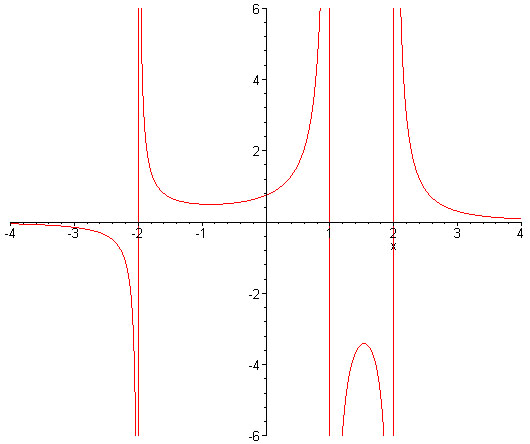Solution: Use the Decay Law,
![]()
where T is the half-life of the material. In this case N(0) = 5 and T = 1.27. Thus,
![]()
and since we want N(t) = 0.6 we need to solve for t, that is,
![]()
and so
![]()
![]()
Be sure to include all asymptotes and find all critical points, maxima and minima and points of inflection, if any.
Solution: The first derivative is given by
![]()
The critical points are given by the set of numbers
![]()
where the two terms involving square roots are the zeros of the quadratic (obtained by the quadratic formula) in the numerator of the expression ![]() and the other numbers arise since
and the other numbers arise since ![]() is not defined at those points.
is not defined at those points.
The SDT of ![]() is given by
is given by

Note the ``minus sign'' in the expression for ![]() . We have just found the SDT for
. We have just found the SDT for ![]() so we need to change all the signs in the last column to find the correct sign of
so we need to change all the signs in the last column to find the correct sign of ![]() . As a result we find that f is increasing when -0.87 < x < 1.53 and decreasing when
. As a result we find that f is increasing when -0.87 < x < 1.53 and decreasing when ![]() or
or ![]() .
.
Next, the second derivative is given by
![]()
To test the nature of the critical points at ![]() we just calculate
we just calculate
![]()
and so ![]() gives a local maximum. Similarly we can find that
gives a local maximum. Similarly we can find that
![]()
and so there is a local minimum here.
Furthermore, there are three vertical asymptotes at ![]() and x=1 and one horizontal asymptote, namely y=0, at both
and x=1 and one horizontal asymptote, namely y=0, at both ![]() since
since
![]()
Finally there are no points of inflection since ![]() whenever
whenever ![]() or 1 < x < 2 and
or 1 < x < 2 and
![]() whenever -2 < x < 1 or
whenever -2 < x < 1 or ![]() .
.
For example, it suffices to show that the numerator in ![]() . To see this note that if
. To see this note that if ![]() , then
, then ![]() and this factors as
and this factors as ![]() . Its critical points are
. Its critical points are ![]() . The Second Derivative Test shows that
x=0 is a local maximum, x=-1/2 is a local minimum and x=3/2 is a local minimum. The values of p(x) at these points are p(0) = 20, p(-1/2) = 153/8, and p(3/2)= 25/8. This means that 25/8 must be the global minimum value of p(x) and so p(x) > 0 for every x. Since the numerator can never be equal to zero it follows that
. The Second Derivative Test shows that
x=0 is a local maximum, x=-1/2 is a local minimum and x=3/2 is a local minimum. The values of p(x) at these points are p(0) = 20, p(-1/2) = 153/8, and p(3/2)= 25/8. This means that 25/8 must be the global minimum value of p(x) and so p(x) > 0 for every x. Since the numerator can never be equal to zero it follows that ![]() too.
too.
The graph then looks like:

- [5] a)
-

- [5] b)
-

Solution: a) Let ![]() ,
, ![]() . Then
. Then
![]()
b) Note that
![]()
Let ![]() so
so ![]() . When x=1, u = 1 and when x=4, u=2. So the first integral becomes
. When x=1, u = 1 and when x=4, u=2. So the first integral becomes
![]()
The second integral is easy and
![]()
Combining these two answers we get
![]()
![]()
Use Leibniz's Rule. We know that

Simplifying and passing to the limit (using extended real number arithmetic) we find that the second term tends to 0 and so
![]()